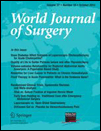Evaluation of Trauma Care in a Mature Level I Trauma Center in The Netherlands: Outcomes in a Dutch Mature Level I Trauma Center
Abstract
Background
Trauma centers are associated with improved survival rates and outcomes in trauma patients. In 2000 our hospital officially became a level I trauma center. The implementation of the trauma center model showed a significant reduction in mortality and hospital length of stay in our hospital and throughout the trauma region. The aim of the present prospective database study was to present the outcomes of patients treated during the course of further maturation of a level I trauma center.
Methods
We performed the prospective database study and included and analyzed outcome data for all adult trauma patients admitted to our trauma center during the years 2003 through 2006 (period 1) and 2007 through 2010 (period 2).
Results
A total of 5,299 patients were included; 2,419 in period 1 and 2,880 in period 2. Mean Injury Severity Score (ISS) increased from 12.6 to 13.8 (p < 0.001). Mean Revised Trauma Score decreased from 7.4 to 7.2 (p < 0.001). Penetrating injuries increased from 111 (4.6 %) to 192 (6.7 %) (p < 0.001). More head injuries (+7.2 %) and spine injuries (+3.1 %), and fewer injuries to extremities (−6.5 %) were seen in the second period. Mortality, adjusted for age and ISS, was lower in period 2 (odds ratio [OR]: 0.736, p = 0.010). Adjusted for age, ISS, and survival, both the hospital stay and the intensive care unit stay were shortened (OR: 1.068, p < 0.018; OR: 1.188, p = 0.007). Mean probability of survival was significantly higher in the second period. Moreover, more unexpected survivors were seen in the second period (Z-score of 3.4 and W-value of 1.46).
Conclusions
Maturation of the trauma center and the trauma system resulted in improved patient outcomes. A significant increase in unexpected survivors was noted, and shorter hospital stay and ICU stay were achieved. Of note, population-based studies on trauma system and trauma center performance with statistical analysis by logistic regression are considered strong class III evidence.




